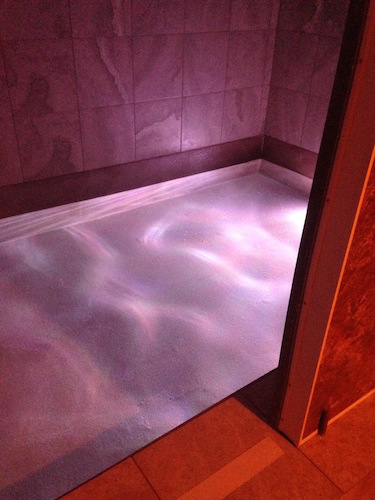The feeling of complete weightlessness, sustained by 1,000 pounds of Epsom salts in a shallow tank of temperature-controlled water is an experience akin to the supreme buoyancy of the Dead Sea, except with much more levity. It’s also an ancient health remedy making a resurgence in fitness and wellness culture today.

Known as flotation therapy, or sensory deprivation, among other similar terminologies, the concept couldn’t be simpler: you effortlessly float in salt water, void of sound or lights, for a sustained period of time, usually an hour or more. And voila, physical and mental health benefits abound.
So, why am I writing about an experience that lacks any auditory or visual elements you might be wondering? We spend so much time focusing on enhancing experiences with these components, but it was just this isolation from the senses that left me contemplating their impact. Sometimes, we need to retreat from our everyday familiarities in order to get a fresh perspective.
As I rested in one of these restricted environmental sensory tanks (REST), at Float, a flotation therapy center in Marlton, NJ, it occurred to me just how important hearing and seeing are to physical and mental well-being. The float experience actually begins and ends with calming music and LED lighting. This is primarily for trust, I was told by Tom Bazis, owner of Float. “You can’t just throw people into a silent, dark room. That can be jarring,” he said. “Music and light eases the process.”
Additionally, meditative music has been clinically proven to even brain waves, helping to shift the mind from alertness to restfulness at that frequency, he pointed out. In water, every surface of the body becomes a receiver for those frequencies, aiding the fade into sensory deprivation, and the inherent healing process that results.

A float isolation tank.
Bazis happens to have been educated as a lighting designer in his earlier life, so naturally, he designed the Float space to create an environment where everything is conducive to relaxation and safety. The way that light reflects off the surface of a table can make it warm and inviting was one example he proffered. “We have strong emotional associations to color that is foundational to our experiences,” he noted. He set out to use LEDs in his flotation therapy center to help control the environment and play with functionality, “painting a picture for an emotional experience.”
It’s ironic how an activity that relies on a vacuum of senses can still be rooted in the impact of sights and sounds. It’s at the heart of what we provide with audio and video everyday: their fundamental utilitarianism. Whether it’s helping people do business together more effectively, disseminating information for practical or educational means, entertaining, or combatting health issues, there’s no substitute for what affects the human senses.

